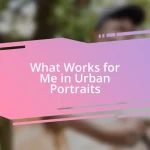Key takeaways:
- Street photography failures serve as valuable lessons; analyzing missed shots can fuel personal growth and improvement.
- Engaging directly with subjects and being proactive enhances the warmth and storytelling in photographs.
- Mastering lighting techniques and varying perspectives can significantly elevate the quality and impact of outdoor street photography.

Understanding street photography failures
Street photography failures can be quite humbling, reminding us that even the most skilled photographers miss the mark sometimes. I remember a rainy afternoon when I spotted a poignant scene—a couple laughing under a shared umbrella—but my timid approach led to a missed shot. Why do we hesitate when the moment speaks so loudly?
Understanding these failures is vital to growth. Each time I stumble, I analyze what went wrong, whether it was my timing, angle, or simply not being bold enough. Have you ever felt that pang of regret after missing a unique moment? Embracing these emotions can turn our missteps into fuel for improvement.
Failures in street photography aren’t merely setbacks; they offer rich lessons. For instance, I learned the importance of anticipation during a bustling festival, where a missed action shot—a child jumping into a puddle—taught me to always be ready. Reflecting on these moments, I find myself asking: what can we learn from each fleeting experience? This mindset transforms failures into stepping stones toward mastery.

Common mistakes in street photography
Street photography can often be a dance of timing and intuition, but many of us stumble on the basic principles along the way. One prevalent mistake I’ve encountered is failing to engage with the subject directly. I recall a day in a crowded market when I spotted an elderly man selling flowers. Instead of approaching him, I hesitated and shot from a distance. The result? A picture that lacked the warmth and connection that could have been captured through engagement. Isn’t it amazing how a simple conversation can transform a flat image into a story?
Another common misstep is improper use of the camera settings. In my early days, I became overly fixated on manual settings, believing I needed to control every aspect. I found myself missing spontaneous moments because I was too busy adjusting my aperture and shutter speed. One time, a street performer captured my attention mid-jump, but by the time I was ready, the moment had passed. It led me to realize that sometimes, it’s better to go with auto settings, allowing your instincts to guide you in the moment.
Many photographers also fall into the trap of overthinking composition. I remember spending countless moments trying to get the perfect leading lines in a busy urban scene. This fixation led me to miss raw, candid interactions that told powerful stories. Sometimes, I’ve learned, the beauty lies in the chaos rather than in perfect alignment. Every missed shot teaches us something critical about being present and responsive to our surroundings.
| Common Mistakes | Personal Insights |
|---|---|
| Failure to Engage | Missing the essence of a moment by not connecting with the subject. |
| Poor Camera Settings | Technical obsessiveness can lead to missed opportunities in spontaneous situations. |
| Overthinking Composition | Focusing too much on rules can overshadow the unexpected beauty of candid interactions. |

Lessons from my street photography
Capturing the essence of a moment in street photography often hinges on our willingness to dive in headfirst. I’ve learned that being proactive is crucial; on one occasion, I was standing on a busy sidewalk when I spotted a young girl twirling in her mother’s coat. My instinct told me to move closer, but fear held me back. The moment vanished before I could press the shutter. It hit me then that vulnerability in our approach often yields the richest rewards.
Reflecting on my journey, certain lessons stand out:
- Be Fearless: Embrace the vulnerability that comes with stepping outside your comfort zone.
- Stay Open to Serendipity: Some of my favorite shots were unplanned, showcasing the spontaneous magic of the streets.
- Trust Your Instincts: There are times when overthinking can cloud our judgment; trusting that gut feeling is essential.
- Learn to Listen: Sometimes, the stories behind the images can be uncovered just by being present and paying attention to the world around you.
Every encounter invites a unique story, and I’m continually learning that those moments often require me to take a leap of faith.

How to improve composition skills
Improving composition skills in street photography often starts with trusting your instincts. I remember standing in front of a graffiti-covered wall, wrestling with the inclination to perfectly frame the subject within it. Instead of overthinking the rules, I decided to let my intuition guide me. The result was a striking image of a passerby, seemingly dancing with the colors behind them, that I never would have captured if I’d clung too tightly to the conventional guidelines.
Another practical tip is to explore various perspectives. I once noticed a street musician’s performance from a distance and thought, “This is a great shot!” Yet, when I ventured closer and changed my viewpoint to the ground, the scene transformed. From that lower angle, I captured not just the musician but also the captivated audience behind him. How can such a simple change in perspective make such a monumental difference? It taught me to constantly seek fresh angles and viewpoints because the same scene can yield entirely different compositions.
Lastly, I’ve found that practicing with minimal distractions can sharpen my composition skills. During a bustling festival, I challenged myself to capture a series of shots with just one lens. By doing so, I focused more on framing, light, and moment rather than getting caught up in equipment changes. The tighter constraints pushed me creatively, leading to an unexpected series of powerful images that conveyed the festival’s energy beautifully. So, what if you tried limiting yourself to a single camera setting for a day? You might just unlock new dimensions in your compositions.

Mastering lighting techniques outdoors
When it comes to outdoor street photography, mastering lighting is crucial for capturing striking images. I remember a sunny afternoon in my city where the light was incredibly harsh, creating unflattering shadows on the faces of passersby. Rather than abandoning the shoot, I sought shade from an overhang, allowing the soft light to diffuse and create a more flattering portrait. How often do we overlook the potential of our environment to soften the light?
Additionally, I’ve learned that golden hour can be a magical time for street photography. One evening, I found myself at a bustling street market as the sun dipped low, casting a warm glow over the scene. The rich colors of the fruit stalls and the vibrant expressions on people’s faces came alive with that beautiful light. I couldn’t help but appreciate how a simple adjustment in timing transformed ordinary moments into something visually stunning. Do you often plan your shoots around the golden hour? It can truly elevate the quality of your work.
I’ve also experimented with backlighting to add a dramatic flair to photographs. One memorable moment was capturing a couple silhouetted against a setting sun while they shared a private laugh. The light behind them created a striking contrast that drew attention to their joyous connection. This taught me to always be aware of the sun’s position. Are you careful to look for opportunities to utilize backlighting, or do you often chase direct light instead? Embracing different lighting techniques can open a whole new avenue for creativity in your outdoor shots.

Engaging with subjects effectively
Engaging with subjects effectively demands a connection beyond just pointing the camera. I recall a rainy day when I spotted an elderly woman sheltering beneath a bright red umbrella. Instead of merely photographing her from a distance, I approached her and struck up a conversation about the weather. Her laughter as we discussed how umbrellas can be both a nuisance and a joy added depth to my images. Have you ever considered how a few kind words could transform a fleeting moment into a timeless portrait?
I’ve often found that the best shots come when I show genuine interest in my subjects. There was a time when I was at a local art fair, and I noticed a painter deeply absorbed in her work. Instead of taking a quick snapshot, I asked her about her inspirations. The moment I captured her smile while sharing her story turned out to be far more powerful than simply capturing her painting. It makes me wonder: how many stories are waiting to unfold if only we take a moment to engage?
Body language is another critical aspect of engaging with subjects. I once photographed a group of teenagers at a park who were initially shy and guarded. By mimicking their carefree gestures—like playful poses and laughter—I created a sense of comfort. What surprised me was how their demeanor shifted, leading to the best candid shots I’ve ever taken. Have you ever thought about how your energy can influence the mood of a photograph? Embracing this can deepen your connection with your subjects and elevate your work dramatically.














